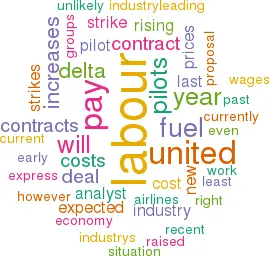Labour costs spiral in the US
March 2001


Last year the main concern was rising fuel prices. Now everybody is worried about potential strikes, as labour contract negotiations are breaking down all around, and about the adverse effects of a slowing economy on demand and unit revenues. Yet, the biggest threat facing the US airline industry is rising labour expenses.
When fuel prices reached their recent peak late last year, Standard & Poor’s analyst Philip Baggaley put the situation in perspective when he pointed out that fuel prices were still not that high by historical standards. His main concern on the cost side was rising labour expenses — a bigger and more permanent threat than fuel.
Labour is the single largest cost category for airlines, usually accounting for at least one third of operating costs. Unlike fuel, labour costs have been rising faster than inflation since the early 1990s, and the trend accelerated last year with extremely expensive contracts like United’s new deal with its pilots.
The United standard
United was in an unusual situation in that all of its labour contracts became amendable with the ending of the ESOP last year. Its pilots were determined to restore their 1994- level wages to industry–leading rates, and in order to avoid further costly work slowdowns United basically gave them what they wanted.
They secured immediate pay rises of 21.5–28.5%, followed by four annual 4% increases. This raised their pay 2–19% (depending on aircraft type) over the highest rates currently paid in the industry.
The deal, ratified in October, raised the bar for the rest of the industry, not just for pilots but right across employee groups.
Suddenly, even the leaders of other major airlines began talking about "industry–leading" contracts, which would be indexed to pay at leading competitors. "Each airline’s contract is expected to establish a new benchmark that will subsequently be surpassed by others in a leap–frog progression of ever–higher pay", observed Baggaley.
The first concrete indication that this is indeed happening came in early February, when Delta offered its pilots wages that exceed those of United’s. The proposal included initial 7–17.5% rises and subsequent annual increases that would add up to 23–34% higher pay over the four–year contract.
Delta Express pilots would be paid more than their counterparts at Southwest. Delta also dropped its earlier controversial proposal to link pay increases to pilot productivity and company performance.
However, the pilots merely called the proposal "a step in the right direction", as there remained disagreement over issues such as retroactive pay, job protection, use of regional jets and elimination of a lower pay scale at Delta Express. The two sides failed to reach agreement by their self–imposed February 28 deadline and were expected to ask to be released from federal mediation, which would start a 30–day countdown to a possible strike.
Not even Southwest appears immune to these new labour attitudes. Its pilots union is believed to have asked for an early renegotiation of its current labour contract, which will not become amendable until September 2004. One analyst suggested this was a direct consequence of the United pilot deal and Delta’s latest offer to Delta Express pilots.
The United pilot deal obviously also raised the expectations of other labour groups at United. Its mechanics, who have been staging work slowdowns, are talking about "zooming right past the highest contracts in the industry", while its flight attendants, who are seeking substantial mid–term pay increases, now want "industry–leading plus" wages.
United will pay a heavy price for the new contracts. Its labour costs are currently expected to surge by at least 20% in 2001. The latest estimate from Merrill Lynch is that the US industry’s labour costs will rise by 12% this year.
UAL’s CFO Douglas Hacker recently predicted that, as has often happened in the past, revenue gains would soon offset the labour cost increases. However, that seems very unlikely if the economy slows further. Reduced demand and higher domestic capacity growth will diminish the industry’s ability to raise fares. Merrill Lynch analyst Michael Linenberg suggested recently that there may not be any system–wide fare increases for at least the next two or three quarters.
The only bright spot is that fuel prices have declined a little in recent months. American, for example, expects paying 6.4% less per gallon of fuel in the current quarter than in the December quarter. But any fuel savings will, of course, be overwhelmingly offset by labour cost hikes.
While the US industry’s aggregate earnings are expected to decline in 2001, United currently estimates that it will only break even this year if the US Airways acquisition goes through.
The current labour situation in the US is highly unusual in that the four largest carriers — United, American, Delta and Northwest — are all involved in contract negotiations with key unions. The talks are difficult as workers' expectations are high (in the wake of the United pilot deal) while managements are concerned about a slowing economy. All are experiencing some type of job actions or overtime refusals, which have led to flight delays and cancellations, and may face strikes.
However, UBS Warburg analyst Sam Buttrick reassured investors in a recent research note that overlapping strikes, or any strikes for that matter, are extremely unlikely. First, the National Mediation Board controls the timing of a potential strike and is unlikely to allow overlapping cooling–off periods. Second, President Bush has signalled his intent to intervene if necessary. A Presidential Emergency Board could delay any strike by 60 days.
Of course, none of that would solve anything. The past year has demonstrated how a key labour group’s mere refusal to work overtime, if over a period of several months, can inflict almost as severe financial damage as a typical short airline strike.